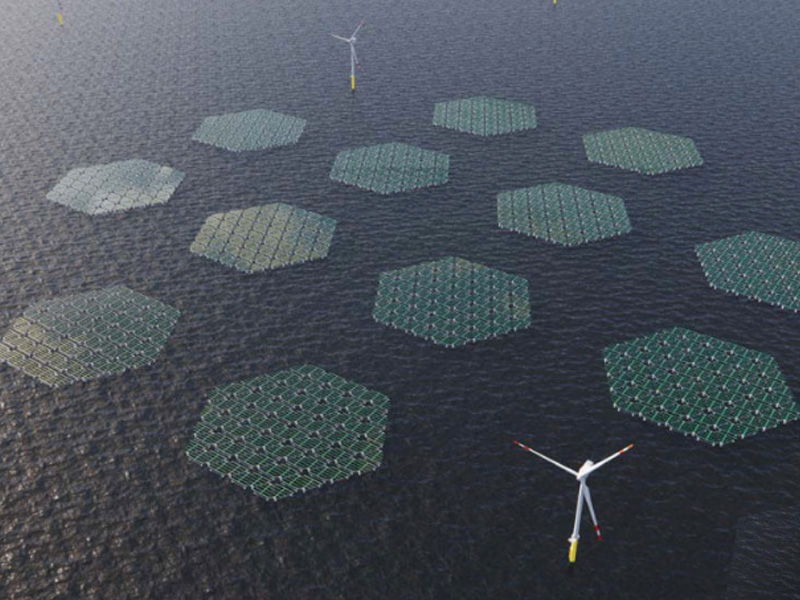Building on the moderate success of floating PV projects in lake and dam construction around the world over the past few years, offshore projects are an emerging opportunity for developers when co-located with wind farms. may appear.
George Heynes discusses how the industry is moving from pilot projects to commercially viable large-scale projects, detailing the opportunities and challenges ahead. Globally, the solar industry continues to gain popularity as a variable renewable energy source capable of being deployed in a range of different regions.
One of the newest, and possibly most important, ways to harness solar energy has now come to the forefront of the industry. Floating photovoltaic projects in offshore and near-shore waters, also known as floating photovoltaics, may become a revolutionary technology, successfully producing green energy locally in areas that are currently difficult to develop due to geographical restrictions.
Floating photovoltaic modules work in basically the same way as land-based systems. The inverter and array are fixed on a floating platform, and the combiner box collects DC power after power generation, which is then converted into AC power by the solar inverter.
Floating photovoltaics can be deployed in oceans, lakes, and rivers, where building a grid can be difficult. Regions such as the Caribbean, Indonesia, and the Maldives could greatly benefit from this technology. Pilot projects have been deployed in Europe, where the technology continues to gain further momentum as a complementary renewable weapon to the decarbonization arsenal.
How floating photovoltaics are Taking the world by Storm
One of the many benefits of floating photovoltaics at sea is that the technology can co-exist with existing technologies to increase energy production from renewable energy plants.
Hydropower stations can be combined with offshore floating photovoltaics to increase the capacity of the project. The World Bank’s “Where the Sun Meets the Water: Floating Photovoltaic Market Report” states that solar capacity can be used to increase the project’s power generation and can also help manage low energy consumption by allowing hydropower plants to operate in a “peak-shaving” mode rather than a “base load” mode. water level period.
The report also details other positive impacts of using offshore floating photovoltaics, including the potential for water cooling to increase energy production, reducing or even eliminating shading of modules by the surrounding environment, no need to prepare large sites and ease of installation and deployment.
Hydropower is not the only existing renewable generation technology that could be supported by the arrival of floating photovoltaics at sea. Offshore wind can be combined with offshore floating photovoltaics to maximize the benefits of these large structures.
This potential has generated great interest in the many wind farms in the North Sea, which provide the perfect prerequisites for the development of floating photovoltaic power plants at sea.
Oceans of Energy CEO and founder Allard van Hoeken said, “We believe that if you combine offshore floating photovoltaics with offshore wind, projects can be developed much faster because the infrastructure is already there. This helps to the development of technology.”
Hoeken also mentioned that if solar power is combined with existing offshore wind farms, a large amount of energy could be generated in the North Sea alone.
“If you combine offshore PV and offshore wind, then just 5 percent of the North Sea can easily provide 50 percent of the energy the Netherlands needs every year.”
This potential demonstrates the importance of this technology for the solar industry as a whole and countries transitioning to low-carbon energy systems.
One of the biggest benefits of using floating photovoltaics at sea is the space available. The oceans provide a vast area where this technology can be used, while on land there are many applications vying for space. Floating PV could also allay concerns about building solar farms on agricultural land. In the UK, concerns are growing in this area.
Chris Willow, head of floating wind development at RWE Offshore Wind, agrees, saying the technology has huge potential.
“Offshore photovoltaics has the potential to be an exciting development for onshore and lakeside technologies and open new doors for GW-scale solar power generation. By circumventing land scarcity, this technology opens up new markets.”
As Willock said, by providing a way to produce energy offshore, offshore PV eliminates the problems associated with land scarcity. As mentioned by Ingrid Lome, senior naval architect at Moss Maritime, a Norwegian engineering firm working on offshore developments, the technology could be applied in small city-states like Singapore.
“For any country with limited space for terrestrial energy production, the potential for floating photovoltaics at sea is huge. Singapore is a prime example. An important benefit is an ability to generate electricity next to aquaculture, oil, and gas production sites, or other facilities that require energy .”
This is crucial. The technology could create microgrids for areas or facilities that are not integrated into the wider grid, highlighting the technology’s potential in countries with large islands that would struggle to build a national grid.
In particular, Southeast Asia could gain a huge boost from this technology, especially Indonesia. Southeast Asia has a large number of islands and land that are not very suitable for solar energy development. What this region has is a vast network of water bodies and oceans.
The technology could have an impact on decarbonization beyond the national grid. Francisco Vozza, the chief commercial officer of floating PV developer Solar-Duck, highlighted this market opportunity.
“We’ve started to see commercial and pre-commercial projects in places like Greece, Italy, and the Netherlands in Europe. But there are also opportunities in other places like Japan, Bermuda, South Korea, and all over Southeast Asia. There’s a lot of markets there and we’re seeing of current applications are already commercialized there.”
This technology could be used to radically expand renewable energy generation capacity in the North Sea and other oceans, accelerating the energy transition like never before. However, several challenges and obstacles must be overcome if this goal is to be achieved.
Post time: May-03-2023

